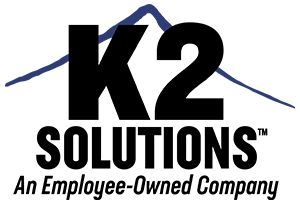
Pepper the dog search for Husky oil on James Smith Cree Nation.
K2 Solutions, Inc., in partnership with Owens Coastal Consultants (OCC), deployed Oil Detection Canines to Saskatchewan to assist in the Husky Oil cleanup. Canines Patton and Pepper were able to detect areas of oil along shorelines, which allowed Environment Canada to map the extent of the spill and reinforce cleanup efforts. Read the article from paNOW below:
Sniffer dogs find Husky’s oil on James Smith Cree Nation
“After two months of fighting for compensation and acknowledgement, residents of the James Smith Cree Nation are finally starting to see results along the Saskatchewan River.
Using dogs trained to recognize the scent of Husky’s oil, the James Smith Cree Nation finally received confirmation of whose oil plume rolled through its lands.
“Push comes to shove, those dogs were trained for that spill site,” James Smith Cree Nation’s Chief Wally Burns said. “When the dogs came in, the dogs picked up that scent of oil that was upstream from (the) Maidstone area.”
The dogs are part of the Shoreline Cleanup Assessment Technique (SCAT). The independent SCAT team maps oil conditions and shoreline types, reports the data and makes recommendations on clean up, according to Shannon Macdonald.
Macdonald is one of two SCAT team leads involved with the James Smith clean-up efforts. She said the dogs are leading all clean-up efforts, followed closely by their handlers and then a clean-up team.
“It’s a very efficient way of doing it, we’re detecting the oil and it’s being cleaned up at that time,” Macdonald said.
The dogs wear a GPS tracking collar, which the handlers use to mark spots where oily driftwood or vegetation is. Handlers also wear a GPS unit, to mark any spots where they find oil.
Sixteen kilometers of river bank will be cleaned along both sides of the Saskatchewan River, according to Macdonald. Clean up crews are responsible for removing vegetation and driftwood along the river banks.

Oil detected by Pepper is marked with a flag
Until now, the band and Husky Energy had meetings after oil and tar-like substances were discovered in the area. Representatives from Husky said the company would not claim responsibility as the oil was not identified as their own.
The band received compensation on Monday. Burns previously said to paNOW the clean up efforts cost the band roughly $150,000 out of pocket, but as for whether the full amount was delivered by Husky is unclear; a dollar amount was not made available.
This process is a start, according to Peter Chapman Cree Nation Chief Robert Head.
“There’s going to be an ongoing process that we have to be involved in,” Head said. “Because the oil sinks to the bottom of the river during the freeze up and the break-up of ice in the spring, the oil is going to be released back into the environment.”
Officials from the James Smith Cree Nation, the Ministry of Environment, Husky, and clean-up crews participated in pipe and water ceremonies before clean up began. According to Burns, this was done to honour the traditional ways of First Nations people and to ensure the safety of workers along the waterway.
According to Burns, James Smith will now be taking baby steps, working with Husky and the government to clean up the river.
“Nobody ever thought we’d have a disaster on the river. Dealing with this, it’s going to have a long term effect. Husky has to be here, not only this year, next year (but) years to come,” Burns said.”
A link to the article is located here.

